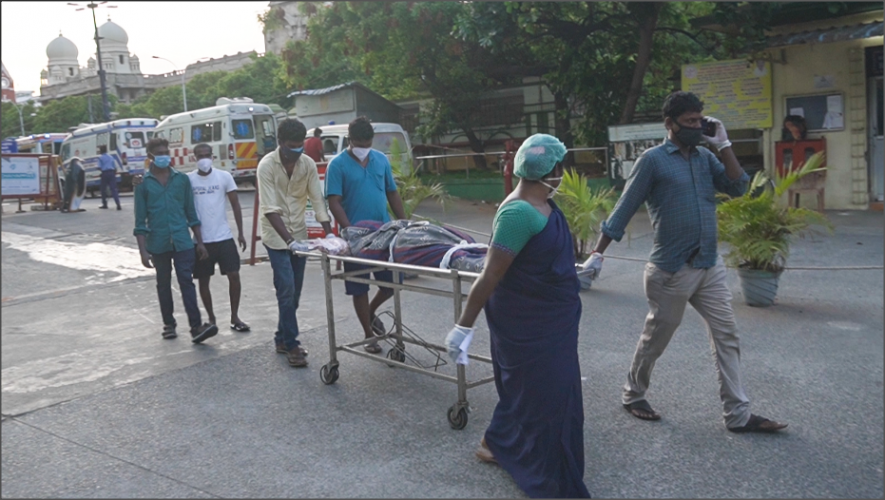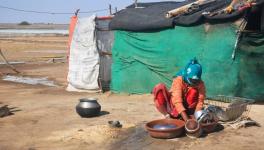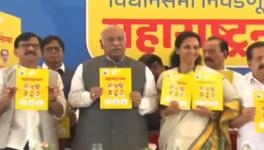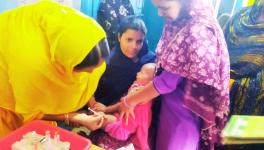A Weak Healthcare Systems Cannot Deal with a Pandemic

Image credit: Lakshmi Kanth Bharathi
For two months, Indians have faced an extremely distressing situation. The visuals of COVID-19 patients choking as hospitals run out of oxygen supplies will stay in public memory for a long time. The tragedies are too many to recount. The question remains: what went wrong? After all, deficiencies in the health sector that prevented it from tackling the pandemic came to light a year ago. Despite this advance warning, the government could not come close to meet the challenges of the second wave and failed to fix possible shortages of essential life-saving equipment and supplies.
Truth is, the problem is not just the pandemic but three other deep-rooted problems that plague the healthcare system. These problems only worsened in recent times, which brings us to the juncture of panic and distress we are at. First, governments failed to allocate enough resources to meet even the minimum satisfactory healthcare for all. Second, there are high and growing inequalities in the healthcare system. We have five-star facilities for the wealthy and public hospitals and community and Primary Health Centres lack essential medicines, basic equipment and doctors. Third, fund allocations for the healthcare needs of ordinary people are tremendously inadequate. On top of it, there is growing pressure to divert resources to such programs as would bring more gains to profit-oriented private health institutions. Many big multinational companies and international organisations run these institutions and push for such policy changes.
An Oxfam report on inequalities during the COVID-19 pandemic (The Inequality Virus and its India supplement) highlights that an underfunded and weak public health system cannot control a pandemic or provide appropriate and timely care to the sick. India has one of the lowest health budgets in terms of share in government expenditure. It keeps Indian public healthcare fragile, weak and understaffed. This is how Indians end up paying 58.7% of their total health expenditure out of pocket, against the World Health Organisation norm of 15-20%.
The Union Budget 2021-22 gives the impression of an increase in expenditure on health. However, it is just an optical illusion created by including the nutrition, sanitation and water supply budgets within a made-up category of health and well-being. If these props (including the COVID-19 vaccination budget) go, the increase in the health budget vanishes too. During the pandemic, non-Covid patients stopped getting regular medical care. Despite this, the government has not made significant hikes in the budget allocation for public health.
In fact, in recent years, the Union and state governments allocated just around 0.35% of the GDP to health. This is shockingly low and the government has accepted that it needs to raise this to 2.50%. The stated goal of the government is to raise the percentage of expenditure every year until it hits this target. However, this year and in the previous financial year, the Union government expenditure (minus the artificial props) fell short by around Rs. 50,000 crores.
When seen as a share of the Union Budget, the health allocation declined from 2.55% in 2017-18 (Actual Expenditure) to 2.21% in 2021-22 (Budget Estimate). This shortage of funds explains why community health centres are short of specialist doctors by close to 80%, while the number of these centres is itself less by about 37% of the stated requirement. (We are short of 23% of sub-centres and 28% of Primary Health Centres too.) India has only 0.55 government hospital beds per 1,000 people whereas the WHO norm is 5 per 1,000 people.
The health sector is starved of funds even during an emergency, but the wasteful Central Vista and the Ken-Betwa river-linking project are still going ahead. In the first, several in-use historic buildings and public spaces will be demolished. In the latter, over two million trees will be axed.
We need to also look at qualitative aspects of healthcare. A recent study of Primary Health Centres by Suneela Garg, Saurav Basu, and other community medicine experts published in June 2020, found that 57% of them had inadequate ventilation, 75.5% had negligible airborne infection control measures, and N95 masks were unavailable in 50% of the facilities surveyed. There is no reason to suppose that the situation has changed in a year. Indeed, the temporary closure of many Primary Health Centres—so that the staff could go on COVID-19 duty in rural areas—also contributed to a situation in which the vulnerable have no reliable source for treatment for regular ailments.
All this is not to say that the government cannot raise resources for urgent health needs. According to the same Oxfam report, if India’s top 11 billionaires are taxed at just 1% on the increase in their wealth during the pandemic, it will be enough to raise the allocation of the Jan Aushadhi Scheme by 140 times. This scheme provides affordable medicines to the poor and marginalised, who are suffering the most during this crisis.
Finally, the contribution of profit-driven private healthcare in meeting the COVID-19 crisis is questionable. Last year, Sanjay Kumar, Principal Secretary of Health, Bihar, took to messaging platform Twitter to express his concern. He wrote: "The almost complete withdrawal of the private health sector in the state is palpable and thought-provoking. Private sector has 48,000 beds as compared to 22,000 in public and does almost 90% of all OPDs (outdoor patient department). Forget COVID-19, even regular services have become unavailable."
The Oxfam report also points to profiteering by many private health establishments during the pandemic. It said the cost of COVID-19 treatment at a private hospital can be 24 times the monthly income of 13 crore Indians who live in extreme poverty. By now, this has become a lived reality for many Indians—and the government did not prevent this from repeating itself this year. The rates of health services and facilities have increased manifold, often overnight, making it difficult for even the well-off to afford them. For instance, a leading private hospital in Delhi set the daily cost for ICU treatment with a ventilator at Rs. 72,500, excluding consultation fees, medicines and consumables.
For close to a year, minus the lull in the pandemic for a few months, the middle class and poor have been struggling to get their sick friends and families to a hospital bed, while the rich and powerful “booked” ICU beds even if they did not have COVID-19 symptoms. By all accounts, shortages of ambulances, beds, ICUs, ventilators, life-saving and ordinary drugs, still plague the system and a black market in all these items is thriving.
The government must stop all wasteful expenditure and divert its resources to the health sector. It must prioritise the need for essential life-saving equipment and medicines. Long-term efforts to strengthen public health in rural and urban areas should get much more attention and resources. There is no short-cut out of these demands and necessities if India is to fulfil any of its aspirations.
Bharat Dogra is a journalist and author. His recent books include Protecting Earth for Children and Planet in Peril. The views are personal.
Get the latest reports & analysis with people's perspective on Protests, movements & deep analytical videos, discussions of the current affairs in your Telegram app. Subscribe to NewsClick's Telegram channel & get Real-Time updates on stories, as they get published on our website.
























